How to Make Camper Skirting Out of Foam Board Insulation
This post may contain affiliate links.
I’ve lived in an RV through the cold winters of Missouri for years. Previously, we made our own vinyl RV skirting to stay warm all winter. But we moved to a new RV park that did not allow us to use the black vinyl skirting we had made ourselves, so we made our own foam board RV skirting instead.
The project was actually easier and cheaper than our DIY vinyl skirting, and we really liked how it turned out.
If you’re looking for the cheapest and easiest way to skirt your trailer or motorhome yourself, foam board insulation is the way to go.
Materials We Used for Skirting Our Fifth Wheel with Foam Board
- 1-inch thick foam board insulation. The kind we used had silver reflective material on one side, which goes inside to reflect heat under your RV. You can use a thicker foam board, but a 1-inch one worked fine for us and was the cheapest.
If you plan to leave it up for multiple years, I would choose a thicker foam for durability. You can paint it a different color if you like, using only latex- or water-based paint. Oil-based paint (including spray paint) will react with the foam, causing it to “melt” or dissolve. - Foil HVAC tape. This is the best type of tape to use for attaching the foam board to your camper because it will stay stuck during cold weather but will pull away cleanly without leaving behind any sticky residue when you need to remove it.
- White duct tape. We used duct tape to join pieces of foam board at the seams. We chose white duct tape to match the foam board and be less visible.
- Tent stakes. We used tent stakes to hold the skirting in place along the bottom. This will only work if you have a dirt ground to pound stakes into. At the end of this article, I’ll provide ideas for holding the skirting in place on other types of ground.
- A permanent marker for marking where to cut the foam board.
- A tape measure for measuring your camper to determine how much foam to buy, and for measuring the foam board for cutting.
- Something to cut the foam board with. We first tried a utility knife (the kind that uses razor blades) but found that a regular knife from the kitchen worked better.
- IMPRESA Aluminum Foil Tape: Experience the unrivaled versatility of IMPRESA's aluminum foil tape, perfect for sealing HVAC systems and ducts. Its robust construction excels in tasks requiring heat resistant, heavy duty foil tape during winter
Video of the Installation Process
We recorded a video demonstrating the process of making the skirting. Watch below, or keep reading for a step-by-step tutorial.
Step 1. Measuring & Cutting
The first step is to measure your camper and determine how much foam insulation you need.
This will depend on the length of your camper and how high your camper sits off the ground. If you’re parked on a slope, you’ll probably have more space on one end of your camper and need more foam to cover the height.
I can’t remember exactly how many pieces of foam board we bought, but it was around 6 or 7. A smaller camper would require less.
Our camper required 2′ of skirting height. Since the sheets of foam insulation were 4’x8′, we cut them in half lengthwise and covered 16 feet of our camper with a single piece. There were a few spots where the height was greater than 2′, like the gooseneck of our 5th wheel. We exposed our gooseneck, but you could patch foam board together or buy a fifth wheel skirt.

The hardest part of this project is measuring and calculating how to cut the foam board. I recommend drawing it out on a sheet of paper first to help you keep your dimensions straight.
Next, we scored the foam board with a knife, then folded it along the cut and ran the knife down the crease on the back side to cut it all the way through.

Step 2. Arranging the Pieces As You Cut
After we had cut several pieces, we put them where they were going to be used so we could see what we still needed to cut.

Optional: Put foam board on the bottom of your slides.
Generally, you only skirt the open areas beneath your RV. However, I have found that attaching foam board to the bottom of each slide helps reduce heat loss through the floor of my slide-outs and makes the camper feel much less drafty.

If nothing else, I would do this to any slides that won’t have skirting around them, like a bedroom slide so high up that the skirting won’t reach it.
Note: Please learn from my mistakes, and DON’T tape the foam board like I did in the above photo. That tape was tough to remove and left behind residue. I recommend using foil HVAC tape instead, which we used in subsequent years.
- TapePlus Excellence: Discover TapePlus Aluminum Tape, a premium choice for HVAC professionals and home improvement enthusiasts. This aluminum tape for ductwork offers durability and reliability in various demanding applications
Step 3. Placing the Pieces of Foam Board
Once cut and arranged, it’s time to place your foam.
If you’re using a type of foam board with a silver reflective material on one side, the silver side goes inside, facing underneath your camper. This is so that the heat will be reflected back under your camper. Putting the silver side facing outward will do nothing except reflect sunlight away from your camper, which is the opposite of what you want.

Step 4. Taping the Foam Board
After I placed the skirting where I wanted it, I taped it to the camper using the foil HVAC tape. I used only enough to hold the skirting in place because we planned to return and seal it all later.
Note that this skirting came up slightly higher than the bottom of our camper. We felt cutting the foam board to the exact height was unnecessary. It was much easier just to cut each piece of foam board in half lengthwise since 2 feet of height was adequate for most of the camper. Work smarter, not harder.

In this spot, a 2-foot piece of foam board was the perfect height, coming just under the edge of our camper.

Because measuring and cutting are the most involved parts of this process, cutting all the pieces at the two-foot mark was an easy way for us to save time, and it didn’t affect the skirting’s efficacy.
Step 5. Securing the Skirting Along the Bottom
This side of our camper was sitting in gravel, so following a tip from one of our neighbors, I dug out a trench (using the claw side of a hammer) for the skirting to sit in.

Then, I packed the gravel up against the skirting on both sides (I packed it on the back first) to help hold it in place.
Unless you’re in a location that gets very high winds, you may not need to do anything more than this to hold the skirting in place along the bottom. However, if you are in a very windy area or if you don’t have gravel, read on. I’ll share some other ideas for holding the skirting in place.

On one side of our camper, the ground was dirt instead of gravel, so to hold the foam board in place on this side we pounded tent stakes into the ground on each side of the foam. This worked very well and made removing a single panel easy if we needed to access the area underneath the RV for some reason.

Here’s a photo of one of the tent stakes on the inside:

Step 6. Joining the Seams
Instead of HVAC tape, we used duct tape to join the pieces of foam board together and to cover the seams between them because it was sturdier and leaving behind residue was not a concern.
We chose white duct tape to match the white foam board so that it would look nicer.

Tip: How to Handle Tricky Spots
Here’s how we handled a few of the trickier parts of our RV, where a straight-edged piece of foam board would not work.
For the front of our RV beneath the cargo access door, we had to cut the foam at a curve. This wasn’t really too difficult. Te just used a marker to mark it first before cutting.

Making a Hole for the Sewage Hose
Here we had to cut out a hole for our sewage hose.

Pro Tip: We used vinyl guttering to make a downhill track for our sewage hose so liquids drain quickly. This way we can leave our sewage hose exposed even in freezing weather. As long as outside temperatures aren’t cold enough to freeze liquid while dumping, you don’t need to cover the hose.
Going Around the Fenders
I cut the foam to fit around this fender and covered the gaps with HVAC tape to create a seal.

The height at the top of the wheel well was more than 2 feet, so I cut an additional piece of foam to fit. I attached it with duct tape on the backside of the foam.

This took a bit of time.
My husband had a different approach to skirting the fender area on the other side of the RV. He simply removed the fender so foam board could be flush against the RV. If you do this, you might want to cover the holes with some HVAC tape to prevent them from rusting.

We just stashed the fender piece underneath the RV with the screws taped to it so they wouldn’t get lost.

Areas with Different Heights
This part of the RV was tricky because it involved different heights. Plus, we wanted to access our water connection (under the corner of the slide) if needed.

Here’s what that area looked like after we got it done.

Skirting Around the Steps
The steps can also be challenging to figure out. After installing the foam, I covered the opening behind the steps with a shower curtain.

Step 7: Sealing the Skirting with Tape
After all of the skirting was in place, we used HVAC tape to tape along the top of it. This created a seal that would prevent heat from escaping and give the room a neat, finished look.


The Finished Project
We were happy with how our skirting looked finished and even happier knowing that we would stay warm without having to worry about our pipes freezing.

I liked this skirting better than our vinyl skirting because once it was finished, it stayed in place. The vinyl skirting sometimes fell down on windy days and had to be rehung.
We decided not to skirt around the front of the RV this time, partly because so much foam is expensive and partly because making skirting that would go around the tongue and tripod would be a hassle.
Our closet is located in that part of the RV, and to help prevent heat loss, I lined it with faux wood planks made from foam that provided extra insulation.
In the past, we tried making vinyl skirting to go around that part of the RV, but it was really difficult to get it to stay in place and the wind would frequently blow under it. In the future, I would invest in a commercially made wind skirt like this one that was specifically designed for that purpose and also provided easy access to the storage underneath.
8 Ways to Secure Foam Board Skirting Along the Bottom
As promised, here are some suggestions for ways to secure your foam board skirting so that it stays in place even in high winds.
- Gravel – If you’re parked on gravel, dig a trench for your skirting to sit in, then pack the gravel up against the skirting on both sides. This is what we did and it’s free!
- Snow – If you are spending winter in a place where snow stays on the ground all winter long, you can pack snow up against the foam board to hold it in place, and this provides extra insulation as well.
- Tent stakes – If you’re parked on dirt or grass, you can use tent stakes on each side of the skirting to hold it in place.
- Spray foam – You can run a line of expanding spray foam sealant along the bottom of your skirting on both sides to fill gaps and attach it to the ground. If your camper is sitting on pavement or concrete, you can put down plastic first (a commenter on my YouTube channel suggested Saran Wrap) so you don’t end up with the difficult task of scraping up all of the foam later.
- Bricks or rocks – If you don’t mind hauling bricks (or buying them only to sell or give away later), you can put bricks on each side of the skirting to hold them in place. Large rocks would work too—even better if you have a bunch of rocks lying around that you don’t have to buy.
- Lumber – Many RVers build a wood frame around the base of their RV to create a structure to attach the foam board. If you are handy with tools this might be a good option, especially if you have access to free wood.
- Sandbags – One RVer who was parked on a concrete pad told me he held his vinyl skirting in place using sandbags that he purchased online and filled with play sand. He ended up dumping the sand at the end of winter.
- Gallon jugs of water – One year we used plastic gallon jugs filled with water to weigh our vinyl skirting, and these could be used to help hold foam skirting in place as well. An added bonus to this is that you’ll have water you can melt and use in emergencies, and a second added bonus is that you can tell by whether the water under your camper is liquid or not how effective your skirting is at keeping the temperature above freezing.
Pros and Cons of Using Foam Board to Skirt an RV
Pros:
- The cost. We spent just $106 on all the materials required to skirt our 38-foot camper.
- The durability. It stayed in place, and we could have used it the following winter if we hadn’t sold that RV. We left it on through the summer, and it stayed nice and cool during the hot summer months.
- Protection from cold. Our vinyl skirting worked just fine for us in temperatures below freezing, down to about 0º F, but if I were planning to spend winter in a place where the temperature regularly dipped below zero, I would trust foam board skirting more than vinyl.
Cons:
- Not environmentally friendly. A big downside for me is that it can’t be easily re-used or transported. You may end up throwing it away and replacing it if you plan to move to a different spot each winter. I was hoping to recycle the foam when we removed it, but they wouldn’t accept our skirting because it was too dirty.
- It doesn’t allow you to move. The main reason we chose vinyl skirting over foam board was that I wanted a type of skirting I could take down and put back up without too much trouble. Our billboard tarp skirting ended up being a bigger hassle to up and take down than I had hoped, especially when it got wet and muddy. It was possible to reuse and could be folded up for transport. Foam board skirting is really intended to be left in place all winter long and would be extremely difficult to transport once cut.
An alternative type of skirting for RVers who move often
If you will be moving a lot during the winter and need a type of skirting that you can quickly take down and put up, I recommend checking out AirSkirts. This type of skirting didn’t exist at the time we were living in our RV, but it’s inflatable skirting made from heavy-duty, puncture-resistant vinyl that you inflate with an electric or battery-powered pump (kind of like inflating a bounce house at a carnival).
The cool thing about AirSkirts compared to traditional vinyl skirting is that it doesn’t actually attach to your RV, so you don’t have to drill holes or put any adhesive on your camper. As it inflates, it takes shape around the various parts under your RV, and these hold it in place.

Do you have other ideas for securing foam board skirting, or any other tips for skirting an RV to share? Leave a comment below!
Read Next: How to Prepare Your RV for Cold Weather
Ashley Mann founded RVinspiration.com in 2017. She handed off the website to new owners in 2022 to launch a new business as an online entrepreneur coach, but she still helps out as the blog editor. Ashley spent three years living full time in a 38-foot, 5th-wheel RV with her husband Josiah and their cat, Kitty. Her favorite thing about RV life is the challenge of finding the perfect way to organize a space, and she loves seeing all the creative and clever ways people come up with to customize their RVs.









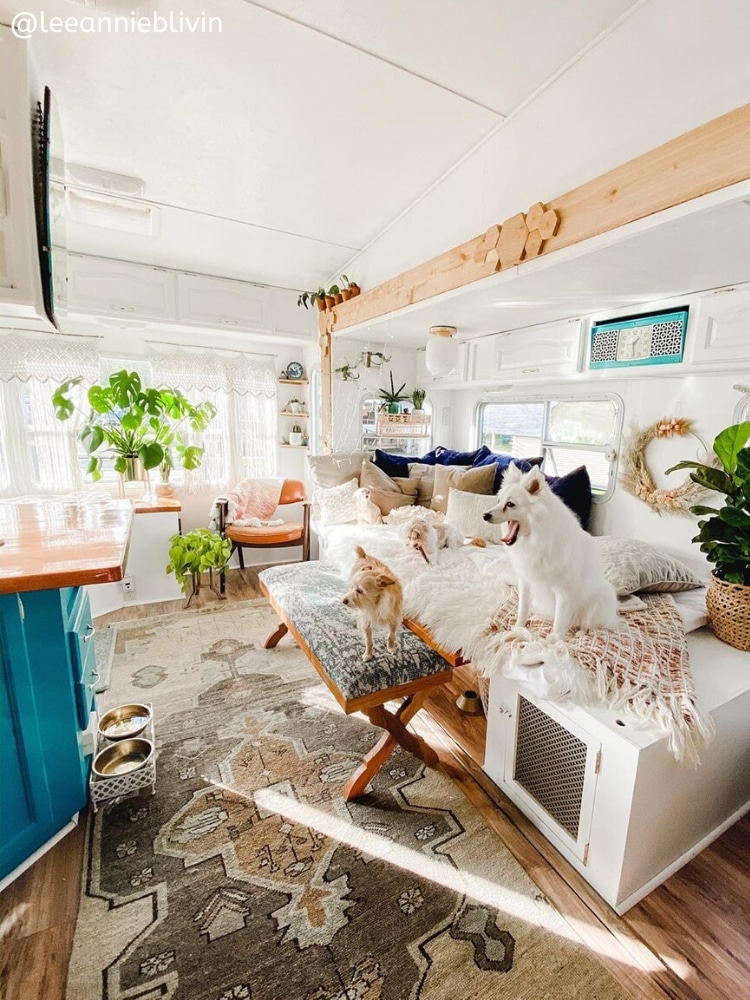

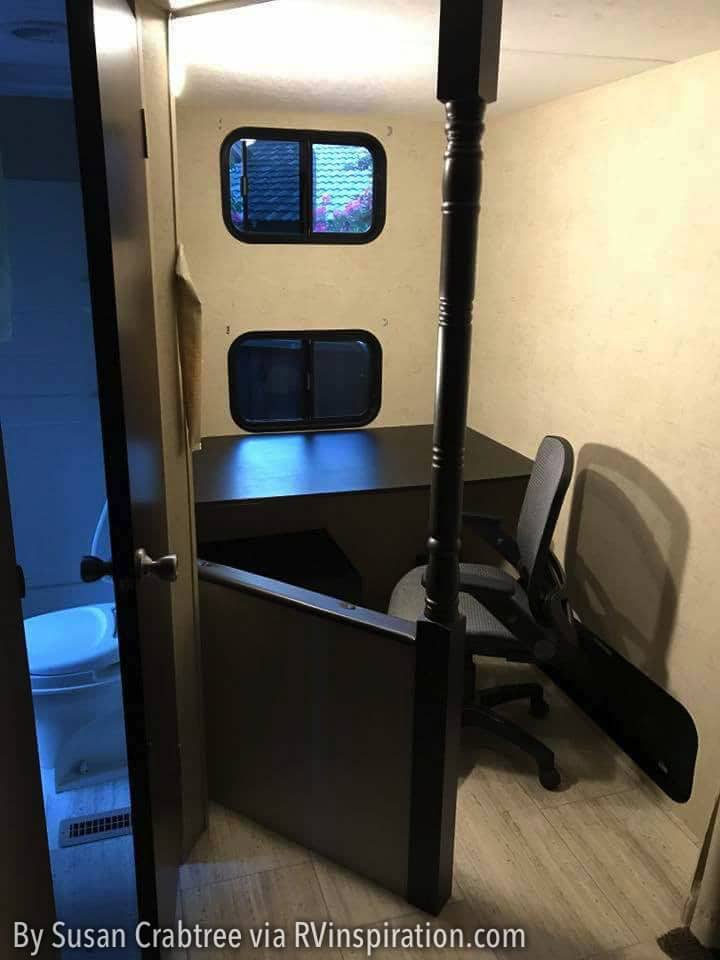
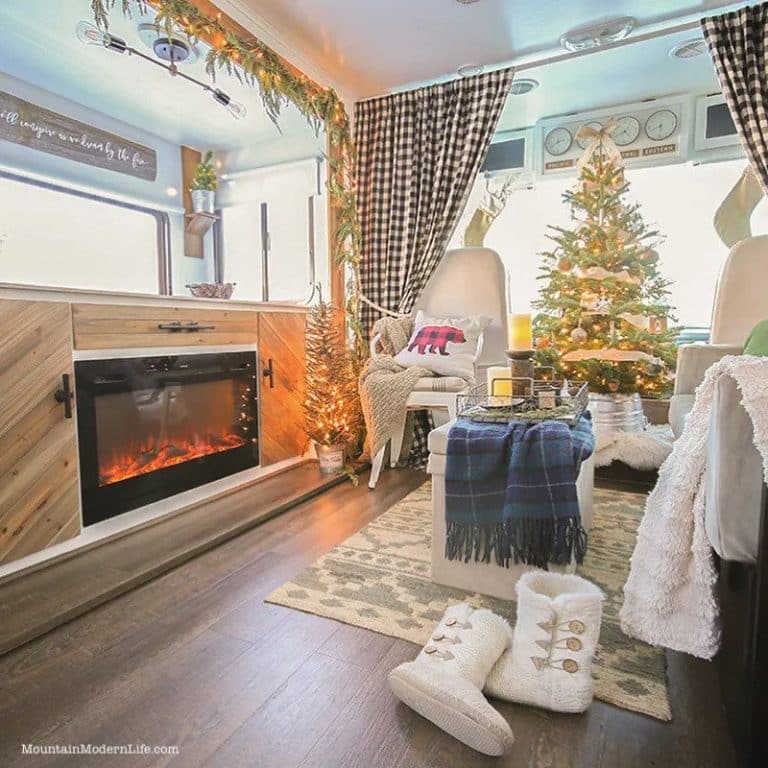
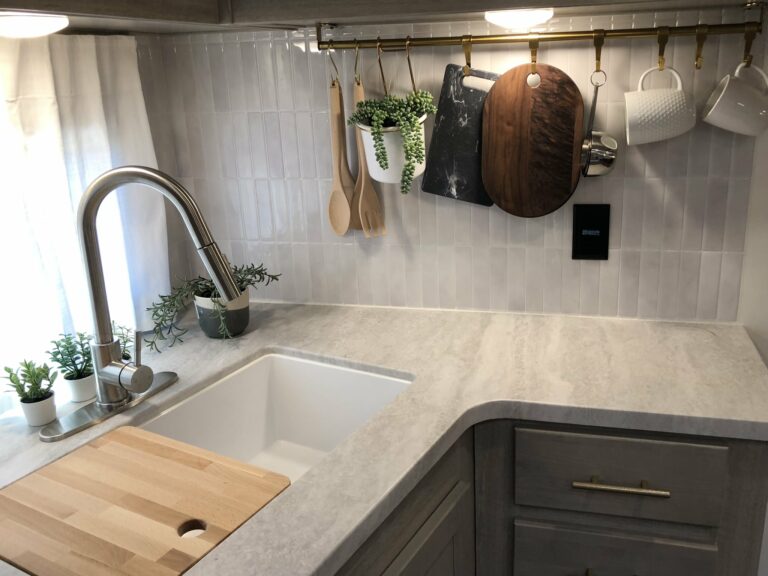
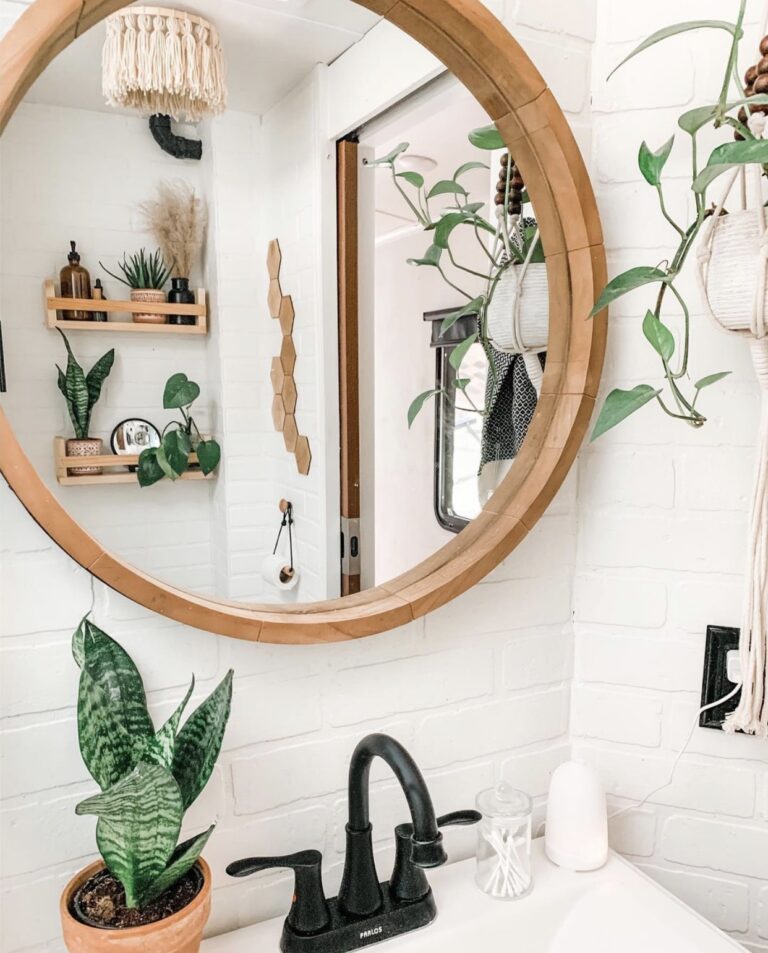
One option if using spray foam is getting a plastic/vinyl drop cloth and put it down before spraying.
Great tip!
Hi there, how much foam board did you buy? I have the same size trailer si I dont want to short myself or buy too much.
Unfortunately, I cannot remember exactly how many pieces we used! I was trying to remember the other day. I am thinking maybe 7? But even with the same camper model you could end up needing more than me if your camper is sitting higher off the ground than mine was, so I would recommend going ahead and measuring anyway. Also, you will need to measure to know exactly how to cut it, so you might as well just calculate the exact amount you’ll need. If you think to come back and let me know how many you bought, I will add your number to the article to help the next person!
Thank you so much for this article – it was a huge help! I got our 39’ Montana skirted in one day, using 10 sheets of foamboard and a full roll of the metal HVAC tape. It made an immediate difference- the furnace runs about 1/3 of the time it used to, saving a ton of money on Propane. (I also plasti-sealed the windows inside.) Other folks in the park where we are set up have been asking a lot of questions – I’m guessing we’re about to see a lot more foam around here!
So glad to be able to help, and that the skirting is helping you save on propane!
If you really want a knife to cut the foam board, purchase the cheapest ” bread knife ” you ca find. They cut way more cleaner than any regular blade or utility knife !! I hate the mess of cutting this stuff and it’s way cleaner to use ! Try it !
Thanks for the tip! I have also heard an electric carving knife works well!
I use a Soldering gun to cut the insulation board. It melts through and dosen’t leave any mess at all. Works very well and if you have trouble with the line being straight just put a board down to use as a guide.
Love this tip! Thanks so much!
Great job. Thank you for sharing.
How much rain do you get in your area and how well does this stand up against rain? I live in an area that gets more rain and ice than snow, but temps can still hit single digits sometimes. I’m wondering how well this would hold up in those conditions. This will be my first winter living in an RV so I really appreciate all of the tips.